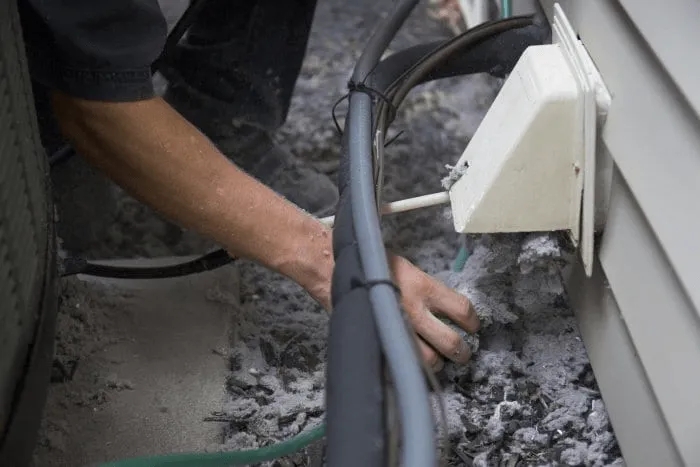Will a dryer vent melt PVC?
Learn why a dryer vent can melt PVC and why using a Dryer Vent Melt PVC is unsafe. Choose safer materials for your dryer vent system.

When installing or repairing a dryer vent, you might wonder, “Will a dryer vent melt PVC?” It’s a valid question because using the wrong material can cause safety risks. PVC (polyvinyl chloride) is a popular plastic pipe material used in many home projects, but is it suitable for a dryer vent? This guide will answer that question and explain why choosing the right materials is important for safety and performance. If you want Dryer Vent Cleaning in Union City, contact MMI Home Improvement Pro.
What Is a Dryer Vent?
A dryer vent is a tube or duct that allows hot air and moisture from your dryer to escape outside your home. However, this prevents heat and humidity from building up indoors, which can cause problems like mold or damage to walls.
Dryer vents are exposed to high temperatures ranging from 120°F to 200°F. Choosing a vent material that can handle this heat is essential. So, is PVC a good option?
What Happens When You Use PVC for a Dryer Vent?
PVC is not designed to handle the high heat of a dryer. Here’s why it’s a bad choice:
-
It Can Melt or Warp
PVC softens at around 176°F and melts at approximately 212°F. Since dryers can produce air hotter than that, PVC pipes may warp or melt, leading to damage.
-
It Releases Toxic Fumes
When PVC overheats, it can release harmful gases. These fumes are dangerous to breathe and can pose a health risk to your family.
-
Lint Buildup Creates a Fire Hazard
PVC generates static electricity, which attracts lint to the inside of the pipe. This lint can block airflow and increase the risk of a fire.
-
It May Not Meet Building Codes
Many building codes prohibit PVC for dryer vents due to these safety concerns. Using PVC could result in fines or require replacement to meet code requirements.
Read: Dryer Vent lint screen: How do I clean Trap and Vent?
Why PVC Is Unsafe for Dryer Vents
The question, “Will a dryer vent melt PVC?” concerns heat resistance. PVC isn’t designed for high-temperature environments like a dryer vent. Using it can lead to problems, including:
-
Warping or melting under heat.
-
Toxic fumes that may spread into your home.
-
A higher risk of lint fires due to static buildup.
What’s the Best Material for a Dryer Vent?
Metal is the best material for dryer vents. Unlike PVC, metal is heat-resistant, safe, and durable. Here are the types of metal dryer vents to consider:
-
Rigid Metal Ducts
-
Made of aluminum or galvanized steel.
-
Strong and long-lasting.
-
Ideal for permanent setups.
-
Semi-Rigid Metal Ducts
-
Flexible but still resistant to heat.
-
Suitable for tight spaces where rigid ducts don’t fit.
-
Flexible Aluminum Ducts
-
Easy to install.
-
A good choice for short, straight vent paths.
Metal dryer vents also have smooth surfaces, which prevent lint buildup and improve airflow.
How to Install a Safe Dryer Vent
If you’re replacing or installing a dryer vent, follow these tips to ensure safety and efficiency:
-
Choose Metal Over PVC
Always select metal ducts for dryer vents. Avoid PVC, vinyl, or plastic materials, as they are unsafe for high-heat applications.
-
Keep the Vent Short and Straight
A shorter, straighter vent helps hot air escape more easily and reduces the chance of blockages.
-
Seal the Connections
Use metal clamps or foil tape to secure all connections and prevent air leaks.
-
Clean the Vent Regularly
Clean the dryer vent every six months to remove lint buildup and ensure proper airflow.
-
Follow Building Codes
Check local building codes and follow the recommendations to make sure your vent system is safe and compliant.
Risks of Using PVC for a Dryer Vent
Let’s revisit the key risks of using PVC as a dryer vent:
-
Melting Under Heat
PVC pipes can’t handle the heat generated by dryers. This can lead to warped or melted pipes.
-
Releasing Harmful Fumes
Overheated PVC emits toxic fumes, which harm health and cause respiratory issues.
-
Fire Hazards
Lint trapped in PVC pipes causes a fire risk, especially with high heat.
-
Code Violations
Using PVC might not meet building codes, leading to costly replacements.
Why Metal Is the Right Choice
If you’re asking, “Will a dryer vent melt PVC?” The answer is clear: yes, it can. PVC isn’t made to handle the high temperatures of a dryer. On the other hand, metal is built to resist heat and is the safest choice for dryer vents.
By choosing metal ducts, you:
-
Prevent melting or warping.
-
Avoid harmful fumes.
-
Reduce fire risks caused by lint buildup.
Summary
PVC is not a safe material for dryer vents. The high heat from a dryer can cause PVC to melt, release toxic fumes, and increase fire risks. Also, always use metal ducts for your dryer vent for safety and efficiency. Metal is heat-resistant, durable, and meets building code requirements. However, choosing the right materials and keeping your vent clean can keep your home safe and your dryer running smoothly. So, will a dryer vent melt PVC? Absolutely. Avoid PVC and choose metal for a safer, more reliable dryer vent system.
What's Your Reaction?
















